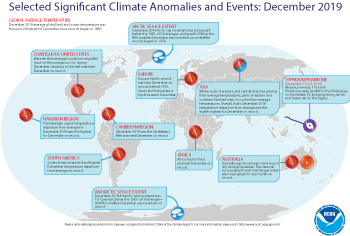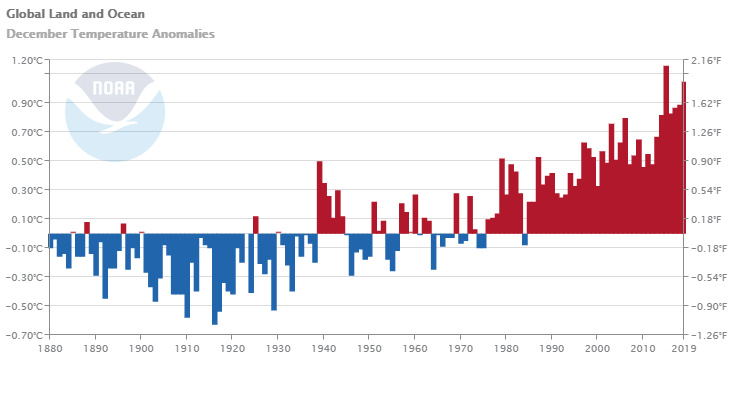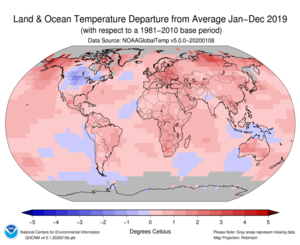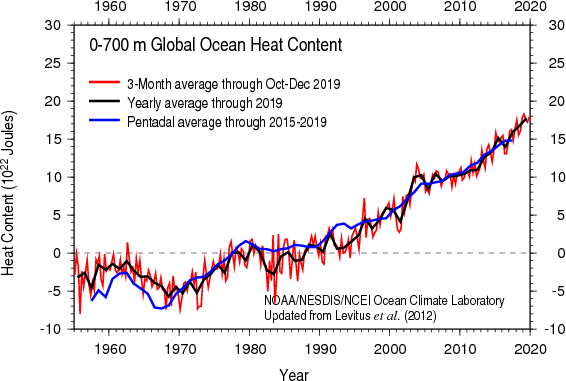Introduction
Temperature anomalies and percentiles are shown on the gridded maps below. The anomaly map on the left is a product of a merged land surface temperature (Global Historical Climatology Network, GHCN) and sea surface temperature (ERSST version 5) anomaly analysis. Temperature anomalies for land and ocean are analyzed separately and then merged to form the global analysis. For more information, please visit NCEI's Global Surface Temperature Anomalies page. The percentile map on the right provides additional information by placing the temperature anomaly observed for a specific place and time period into historical perspective, showing how the most current month, season or year compares with the past.
Temperature
In the atmosphere, 500-millibar height pressure anomalies correlate well with temperatures at the Earth's surface. The average position of the upper-level ridges of high pressure and troughs of low pressure—depicted by positive and negative 500-millibar height anomalies on the December 2019 map—is generally reflected by areas of positive and negative temperature anomalies at the surface, respectively.
Monthly Temperature: December 2019
The December 2019 global land and ocean surface temperature was 1.05°C (1.89°F) above the 20th century average, resulting in the second highest December temperature departure from average in the 140-year record. Only December 2015 was warmer at +1.16°C (+2.09°F). The last six years (2014–2019) were all among the six warmest Decembers on record. Decembers 2015 and 2019 both had a temperature departure from average above 1.0°C (1.8°F). Compared to all months, the December 2019 value was also the eighth highest global land and ocean monthly temperature departure from average for any month on record (1680 months). The 10 highest monthly temperature departures from average have all occurred since 2015 and all have a temperature departure from average above 1.00°C (1.80°F). December 2019 also marked the 35th consecutive December and the 420th consecutive month with temperatures, at least nominally, above the 20th century average. The Northern and Southern Hemisphere land and ocean surface temperatures were also the second highest on record, also trailing behind December 2015.
The global land-only surface temperature was also the second highest December temperature since global records began in 1880, at +1.79°C (+3.22°F). This value is only 0.20°C (0.36°F) cooler than the record warm December of 2015. The global ocean-only surface temperature departure of 0.77°C (1.39°F) above average was also the second highest for December in the 140-year record, behind December 2015 (+0.85°C / + 1.53°F).
Regionally, South America, Europe, Africa, Oceania, and the Hawaiian region each had a December temperature departure from average that ranked among their three highest for December on record. Of note, Oceania was record warm, with a temperature departure from average of +2.75°C (+4.95°F). This was the first time the temperature departure from average was +2.0°C (+3.6°F) or higher during December. This was also the highest monthly temperature departure from average for any month in the 1,320 monthly record. The now second highest monthly temperature departure occurred on October 2015 at +2.61°C (+4.70°F).
December 2019 was characterized by warmer-than-average conditions across much of the global land and ocean surfaces. The most notable warm temperature departures from average were present across much of Europe, western Asia, and Australia, and parts of northeastern Canada, where temperatures were at least 4.0°C (7.2°F) above average or higher. Record-warm December temperatures were observed across most of Australia and across parts of the Indian Ocean, Africa, Europe, the Atlantic Ocean, and the northern and western Pacific Ocean.
| December | Anomaly | Rank (out of 140 years) | Records | ||||
|---|---|---|---|---|---|---|---|
| °C | °F | Year(s) | °C | °F | |||
| Global | |||||||
| Land | +1.79 ± 0.11 | +3.22 ± 0.20 | Warmest | 2nd | 2015 | +1.99 | +3.58 |
| Coolest | 139th | 1929 | -1.30 | -2.34 | |||
| Ocean | +0.77 ± 0.15 | +1.39 ± 0.27 | Warmest | 2nd | 2015 | +0.85 | +1.53 |
| Coolest | 139th | 1910 | -0.49 | -0.88 | |||
| Land and Ocean | +1.05 ± 0.14 | +1.89 ± 0.25 | Warmest | 2nd | 2015 | +1.16 | +2.09 |
| Coolest | 139th | 1916 | -0.63 | -1.13 | |||
| Northern Hemisphere | |||||||
| Land | +1.89 ± 0.11 | +3.40 ± 0.20 | Warmest | 2nd | 2015 | +2.21 | +3.98 |
| Coolest | 139th | 1929 | -1.62 | -2.92 | |||
| Ocean | +0.93 ± 0.15 | +1.67 ± 0.27 | Warmest | 2nd | 2015 | +1.03 | +1.85 |
| Coolest | 139th | 1904 | -0.53 | -0.95 | |||
| Land and Ocean | +1.29 ± 0.13 | +2.32 ± 0.23 | Warmest | 2nd | 2015 | +1.48 | +2.66 |
| Coolest | 139th | 1916 | -0.79 | -1.42 | |||
| Southern Hemisphere | |||||||
| Land | +1.54 ± 0.11 | +2.77 ± 0.20 | Warmest | 1st | 2019 | +1.54 | +2.77 |
| Coolest | 140th | 1916 | -0.70 | -1.26 | |||
| Ocean | +0.65 ± 0.15 | +1.17 ± 0.27 | Warmest | 2nd | 2015 | +0.73 | +1.31 |
| Coolest | 139th | 1909, 1910 | -0.49 | -0.88 | |||
| Land and Ocean | +0.79 ± 0.14 | +1.42 ± 0.25 | Warmest | 2nd | 2015 | +0.84 | +1.51 |
| Coolest | 139th | 1909 | -0.52 | -0.94 | |||
| Arctic | |||||||
| Land and Ocean | +2.00 ± 0.18 | +3.60 ± 0.32 | Warmest | 13th | 2017 | +3.33 | +5.99 |
| Coolest | 128th | 1916 | -2.90 | -5.22 | |||
ENSO-neutral conditions continued during December 2019. According to NOAA's Climate Prediction Center, ENSO-neutral is favored during the Northern Hemisphere winter (Southern Hemisphere summer). This forecast focuses on the ocean surface temperatures between 5°N and 5°S latitude and 170°W to 120°W longitude, called the Niño 3.4 region.
The most current data can be accessed via the Global Surface Temperature Anomalies page.
Select national information is highlighted below. Please note that different countries report anomalies with respect to different base periods. The information provided here is based directly upon these data:
- France had its fifth warmest December since records began in 1900 with a national temperature of 8.1°C (46.6°F) or 2.4°C (4.3°F) above average. Several locations across southeastern France had their warmest December on record. According to Meteo France, the week before Christmas (25 December 2019), maximum temperatures rose above 20.0°C (68.0°F) near the Mediterranean.
- Spain's nationally averaged temperature for December 2019 was 9.9°C (49.8°F), which is 1.9°C (3.4°F) above the 1981–2010 average and the fourth highest December temperature since records began in 1965. Only Decembers of 1989, 2015, and 2002 were warmer.
- Warmer-than-average conditions were present across much of Hong Kong, China. According to Hong Kong's Observatory, the maximum temperature was 1.7°C (3.1°F) above average and one of the four highest December maximum temperatures on record.
-
Australia's maximum, minimum, and mean temperatures were all record high for December. The December 2019 national mean temperature was 3.21°C (5.78°F) above average and exceeded the previous record set in 2018 by +1.08°C (+1.94°F). This was also the highest monthly mean temperature departure from average for any month in the 1320 monthly record, surpassing the previous record of +3.03°C (5.45°F) set in October 2015. The national maximum temperature departure from average of +4.15°C (7.47°F) was 1.74°C (3.13°F) higher than the now second warmest December of 2018 and the highest maximum temperature departure from average for any month. The previous national maximum temperature departure from average was +3.60°C (+6.48°F), also set in October 2015. Regionally, Queensland, New South Wales, South Australia, Western Australia, and the Northern Territory each had their warmest maximum and mean temperatures in the 110-year record. Victoria had its second and third warmest maximum and mean temperatures on record, respectively.
- Extreme heat affected central and southern Australia during mid-December, with several locations experiencing maximum temperatures over 40.0°C (104.0°F). According to Australia's Bureau of Meteorology, December 17 was Australia's hottest day ever on record, with a maximum temperature of 40.9°C (105.6°F), besting the previous record of 40.3°C (104.5°F) set on 7 January 2013. However, the December 17 record was broken the very next day (December 18) with a maximum temperature of 41.9°C (105.6°F).
Year-to-date Temperature: January–December 2019
Please see the NCEI State of the Climate Annual Global Analysis report for additional information.
| January–December | Anomaly | Rank (out of 140 years) | Records | ||||
|---|---|---|---|---|---|---|---|
| °C | °F | Year(s) | °C | °F | |||
| Global | |||||||
| Land | +1.42 ± 0.14 | +2.56 ± 0.25 | Warmest | 2nd | 2016 | +1.54 | +2.77 |
| Coolest | 139th | 1884 | -0.72 | -1.30 | |||
| Ties: 2015 | |||||||
| Ocean | +0.77 ± 0.16 | +1.39 ± 0.29 | Warmest | 2nd | 2016 | +0.79 | +1.42 |
| Coolest | 139th | 1904 | -0.46 | -0.83 | |||
| Land and Ocean | +0.95 ± 0.15 | +1.71 ± 0.27 | Warmest | 2nd | 2016 | +0.99 | +1.78 |
| Coolest | 139th | 1904 | -0.45 | -0.81 | |||
| Northern Hemisphere | |||||||
| Land | +1.46 ± 0.16 | +2.63 ± 0.29 | Warmest | 4th | 2016 | +1.68 | +3.02 |
| Coolest | 137th | 1884 | -0.82 | -1.48 | |||
| Ocean | +0.95 ± 0.16 | +1.71 ± 0.29 | Warmest | 1st | 2019 | +0.95 | +1.71 |
| Coolest | 140th | 1904 | -0.52 | -0.94 | |||
| Land and Ocean | +1.15 ± 0.15 | +2.07 ± 0.27 | Warmest | 2nd | 2016 | +1.21 | +2.18 |
| Coolest | 139th | 1904, 1907 | -0.48 | -0.86 | |||
| Southern Hemisphere | |||||||
| Land | +1.32 ± 0.11 | +2.38 ± 0.20 | Warmest | 1st | 2019 | +1.32 | +2.38 |
| Coolest | 140th | 1917 | -0.72 | -1.30 | |||
| Ocean | +0.64 ± 0.16 | +1.15 ± 0.29 | Warmest | 2nd | 2016 | +0.70 | +1.26 |
| Coolest | 139th | 1909, 1911 | -0.43 | -0.77 | |||
| Land and Ocean | +0.74 ± 0.15 | +1.33 ± 0.27 | Warmest | 2nd | 2016 | +0.77 | +1.39 |
| Coolest | 139th | 1911 | -0.44 | -0.79 | |||
| Arctic | |||||||
| Land and Ocean | +2.14 ± 0.14 | +3.85 ± 0.25 | Warmest | 2nd | 2016 | +2.35 | +4.23 |
| Coolest | 139th | 1902 | -1.44 | -2.59 | |||
Precipitation
December
The maps shown below represent precipitation percent of normal (left, using a base period of 1961–1990) and precipitation percentiles (right, using the period of record) based on the GHCNM v4 beta dataset of land surface stations.
Precipitation anomalies during December 2019 varied significantly around the world. December precipitation was generally drier than normal across parts of Australia, Alaska, across the contiguous U.S. northern Rockies Mountains and in the southern Mississippi Valley, Central America, southern Chile, eastern Brazil, eastern Europe, and across parts of northeastern and southeastern Asia. Wetter-than-normal conditions were notable across the contiguous U.S. southeast, southwest, and northern Plains, northern Europe, and northern and central Asia.
Select national information is highlighted below. (Please note that different countries report anomalies with respect to different base periods. The information provided here is based directly upon these data):
- Wetter-than-average conditions were present across much of Spain during December 2019. The national December 2019 precipitation average was 112 mm (4.4 inches), which is 37% above the 1981–2010 average of 82 mm (3.2 inches) and the 12th wettest December since 1965.
- Extremely dry conditions plagued much of Australia during December 2019, resulting in the driest December in the 120-year record. The national December 2019 precipitation total was only 15.4 mm (0.61 inch) or only 30% of normal December precipitation. Regionally, Queensland and New South Wales had their second driest December with 24% and 14% of normal precipitation, respectively. December 1938 ranks as record dry for both of these states. Meanwhile, Victoria and the Northern Territory had their third and fourth driest December on record, respectively.
- With a record warm and record dry December, the national December 2019 accumulated Forest Fire Danger Index (FFDI) was the highest for any month on record. Overall, more than 5 million hectares (12.4 million acres) had burned across Australia since July through December. It was reported that over 1600 homes have been destroyed and over 15 people lost their lives due to the wildfires. The wildfires also created hazardous air quality.
- Typhoon Phanfone, an equivalent Category 2 hurricane on the Saffir-Simpson scale, formed in the Western Pacific Ocean on 19 December. The storm made landfall over the Philippines just weeks after Typhoon Kammuri (equivalent to a Category 4 hurricane) affected the region. According to reports, Phanfone brought strong winds and heavy rain to the region, causing power outages, damages to buildings, and affecting over 1.5 million people.
Ocean Heat Content
Ocean Heat Content (OHC) is essential for understanding and modeling global climate since > 90% of excess heat in the Earth's system is absorbed by the ocean. Further, expansion due to increased ocean heat contributes to sea level rise. Change in OHC is calculated from the difference of observed temperature profiles from the long-term mean.
| Basin | 0-700 meters | Rank (1955-2023) | |||||
|---|---|---|---|---|---|---|
| Entire Basin | Northern Hemisphere | Southern Hemisphere | ||||
| Atlantic | 7.843 | 4th | 4.145 | 4th | 3.698 | 2nd |
| Indian | 4.161 | 6th | 0.750 | 6th | 3.411 | 7th |
| Pacific | 5.898 | 6th | 2.704 | 8th | 3.194 | 5th |
| World | 17.902 | 4th | 7.599 | 6th | 10.303 | 5th |
| Source: Basin time series of heat content | ||||||
Global OHC for October–December 2019 was the highest October–December OHC, as well as the second highest quarterly OHC, in our records, which extend back to 1955. Overall, the latest quarterly OHC reveals widespread warmer than normal, i.e. the 1955–2006 mean, conditions, a situation observed since the end of 2016. Cool conditions, < -10x105 J/m3, appear in the eastern Indian Ocean extending from the Bay of Bengal to the west coast of Australia. In contrast, the rest of the Indian Ocean shows warmer, > 10x105 J/m3, than normal conditions. Cooler, < -10x105 J/m3, conditions continue to exist around the Philippines in the tropical and subtropical western Pacific Ocean, with the cool signal extending west in the South China Sea and northeastward into the central North Pacific Ocean. Much warmer, > 30x105 J/m3, than normal conditions are still observed in high latitudes off the tip of the Antarctic Peninsula and the northeastern coast of Greenland, while cooler than normal conditions persist in the subpolar North Atlantic Ocean south of Greenland and Iceland. Much higher, > 30x105 J/m3, than normal OHC conditions are observed in the Gulf of Mexico, Gulf Stream/North Atlantic Current, the Northwestern Pacific Ocean, the Southwestern Atlantic Ocean, along the northern Antarctic Circumpolar Current in the Indian Ocean, and off the east coast of Australia.
References
- Menne, M. J., C. N. Williams, B.E. Gleason, J. J Rennie, and J. H. Lawrimore, 2018: The Global Historical Climatology Network Monthly Temperature Dataset, Version 4. J. Climate, in press. https://doi.org/10.1175/JCLI-D-18-0094.1.
- Huang, B., Peter W. Thorne, et. al, 2017: Extended Reconstructed Sea Surface Temperature version 5 (ERSSTv5), Upgrades, validations, and intercomparisons. J. Climate, doi: 10.1175/JCLI-D-16-0836.1
- Peterson, T.C. and R.S. Vose, 1997: An Overview of the Global Historical Climatology Network Database. Bull. Amer. Meteorol. Soc., 78, 2837-2849.
- Huang, B., V.F. Banzon, E. Freeman, J. Lawrimore, W. Liu, T.C. Peterson, T.M. Smith, P.W. Thorne, S.D. Woodruff, and H-M. Zhang, 2016: Extended Reconstructed Sea Surface Temperature Version 4 (ERSST.v4). Part I: Upgrades and Intercomparisons. J. Climate, 28, 911-930.
 NOAA's National Centers for Environmental Information
NOAA's National Centers for Environmental Information













